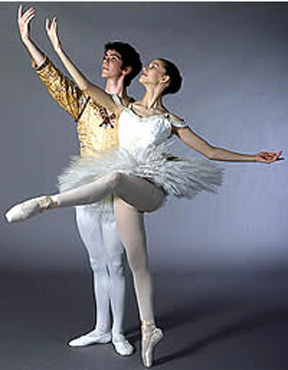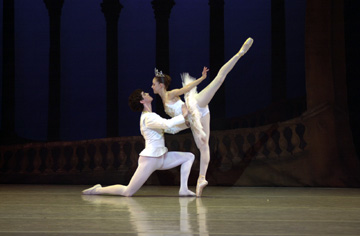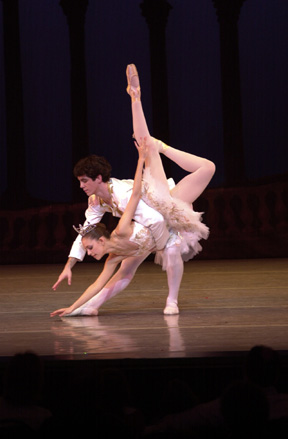Youth and Beauty
The
Sleeping Beauty
Central Pennsylvania Youth Ballet
Whitaker Center for Science & the Arts
Harrisburg, PA
March 27-8, 2004
by
Leigh Witchel
copyright
© 2004 by Leigh Witchel
published 11 April 2004
 One
advantage of youth is that nobody has told you how hard some things are.
You don’t know you can’t do three performances as Aurora back
to back in two days. You just go out and do them. Central Pennsylvania
Youth Ballet’s students are matter of fact about such Herculean
tasks. They perform, go out to the lobby in their tutus and get photographed
with the children in the audience, and then perform again.
One
advantage of youth is that nobody has told you how hard some things are.
You don’t know you can’t do three performances as Aurora back
to back in two days. You just go out and do them. Central Pennsylvania
Youth Ballet’s students are matter of fact about such Herculean
tasks. They perform, go out to the lobby in their tutus and get photographed
with the children in the audience, and then perform again.
The company performed two matinees and an evening show over a weekend in Harrisburg. The matinees were packed with little girls in party dresses and tinsel crowns. Most were seeing their first ballet. They make for a noisy audience, but they’ve come to see ballet, they’re seeing real ballet and their parents are taking them to see it. CPYB is out there on the frontlines, getting them in young and shilling honestly for the art form.
The Sleeping Beauty is a student production, albeit of gifted students. Watching a performance here is one way of knowing who’s going to be in New York City Ballet in five years. Recent CPYB alumni include several NYCB dancers such as Ashley Bouder and Abi and Jonathon Stafford. The company filled almost no roles with adults except for King Florestan (Jonathon Riseling) and Catalabutte, here unnamed and referred to as the Major Domo (Laszlo Berdo), former dancers with Alvin Ailey and Boston Ballet, now guest teachers at the school.
What does it look like when kids do The Sleeping Beauty? Well, they’re kids. Catalabutte’s page (Marcus Romeo) is doing the mime gravely and correctly, but he’s about 10. The Lilac Fairy (Rachel Speck) is around 14. Her attendants, all skilled on point, average around 11. The ballet is truncated by about half an hour, primarily by deleting most of the Vision and Panorama. But we still see the prologue, Aurora’s birthday and the wedding, and the steps are there. Aurora (Anna Gerberich) does the Rose Adagio, though without taking a pose in fifth position en haut between cavaliers. That was a later addition to the choreography and it’s not part of every performance tradition.
Changes in the choreography look like variants rather than simplifications. Magaly Suarez set this version and trained in Cuba, which may account for some of the differences. The second fairy’s variation (here the “Garden Fairy”) contains pas de chats on point (the fifth fairy’s, where we are used to them, doesn’t) and ends with grand jetés instead of piqué turns en dehors. The Lilac Fairy goes from her grand rond de jambe at the beginning of her variation to a Cecchetti attitude instead of an arabesque. The line of Lilac Attendants at the end of the prologue does bourrées instead of emboités, and so on. The only change I really regretted was losing the Lilac Fairy’s bow in first position. It’s been standardized to the foot in back in “b-plus.”
 The
stage of the Whitaker Center is cramped by the size of the production
and some variations were being danced under themselves. But you can see
the schooling with every step. The students’ pointe work is impressively
strong and articulate with shivering, lace-like bourrées even in
cases where the line isn’t yet complete. They also know to stretch
their feet in jumps. The older girls nail balances with a still, photographic
and suspended pose. Port de bras are simple, not flowery and the mime
is very clear if dutiful (but they have to be careful with the mime for
“say”; the hands miming the words need to issue from the mouth,
not the collarbone.)
The
stage of the Whitaker Center is cramped by the size of the production
and some variations were being danced under themselves. But you can see
the schooling with every step. The students’ pointe work is impressively
strong and articulate with shivering, lace-like bourrées even in
cases where the line isn’t yet complete. They also know to stretch
their feet in jumps. The older girls nail balances with a still, photographic
and suspended pose. Port de bras are simple, not flowery and the mime
is very clear if dutiful (but they have to be careful with the mime for
“say”; the hands miming the words need to issue from the mouth,
not the collarbone.)
The production used recorded music with a few odd tempos, slower during some of the fairy variations and very fast at other points, including Aurora’s first entrance. There were also some strange interpolations at Carabosse’s mime for the spindle and before Aurora’s manège in Act III, as well as adding in the three Ivans. The opulent set, borrowed from Louisville Ballet, and the costumes, of which masses had to be built on a shoestring, represented a huge undertaking for the school. It may low-budget, but they’ve got a real baby Aurora, Susanna Gaither, who’s two and watched all three performances from her crib, enchanted, wide-eyed and perfectly silent.
And the kids? Gerberich is around 15, with lovely proportions that are long but not extreme. There’s an elegance to her youth; she’s not the sort to force herself on an audience. Her stage presence is clear, almost transparent: pure water. She was well coached for the part; Amanda McKerrow came down to help, and you could see her modesty in Gerberich’s approach. She occasionally looked over-coached; like the rest of the company with acting and mime, they know what they are supposed to do and now they need to get it under their skin. Gerberich is a very reliable technician; she didn’t bobble through three performances, and along with everyone else got better as the run went on. By Sunday matinee she was floating consecutive triple pirouettes with leisurely endings in her variation after the Rose Adagio, and she’s a good jumper as well.
Her partner and her Lilac Fairy, Ian Hussey and Speck, also did all three performances. Hussey is about the age to go into a company and looks very promising. He’s a left turner and did very well in his variations. The coda was changed to add some extra turns in second for him. Speck’s a nice long scoop of vanilla ice cream, sweet and creamy. She moves big and grew into the part, but as she grows older I think she’ll gain a little extra flavor, perhaps burnt almond or Grand Marnier. Her role is pared down with the loss of the vision scene and the panorama, and we don’t see her in the wedding after her initial entrée until the very end. There are six fairies, so if she’s central it breaks symmetry, which happened several times. But when you’ve got a young Lilac Fairy, a diminished role moved slightly out of center stage seems less inappropriate.
As for the other kids, I’ve worked here and many of them I last
saw as 10 year olds, some in my own ballet in Choreoplan 2001. As a child
said loudly after the fairy variations on Saturday matinee, “I liked
‘em all!” But some you may hear about in a couple of years
include Carli Samuelson, Leta Biasucci and Robbie-Jean Arbaczewski. Samuelson
and Biasucci alternated the Garden Fairy; Arbaczewski performed the fifth
“finger” variation (inexplicably named the “Golden Grape”
fairy here) and alternated with Biasucci as Florine (here, the Enchanted
Princess). Biasucci is polished and dynamic onstage, expressive yet calm;
Arbaczewski a china doll virtuoso. Both were partnered by Robert Kretz,
who had an excellent Sunday performance as the Bluebird that would have
done a dancer much older than 15 proud.
Looking at raw material, Tabitha Rinko-Gay and Brianne George are long
beanpoles of young ladies just starting to get their extremities under
control. New to me was Ashley Day, who did a lovely Diamond variation.
Of the younger men, Owen Thorne is built like a prince with a natural
bent towards mime, to the point where he needs gentle discouragement from
stealing focus and chewing the scenery. Then again, there are no small
parts for tall, princely dancers. First, he needs to work on gaining stretch
in his ankles.
Kelly Clark, 18, played Carabosse, probably the hardest role in the ballet for a young dancer. How does a teenager play Carabosse? Like “Carrie”-bosse, and it had its own validity. She’s less evil then consumed with the feeling of being misunderstood and wronged. She glares sullenly and resentfully at the King and Queen, checking back after every mimed statement to see if it’s finally dawned on their dimly lit souls why she hates them so much. Not until she pronounces her curse does she show a flash of malicious glee.
She was assisted by the clear acting and mime of Riseling, Berdo and LeeAnne Cress as the Queen. Monarchy isn’t visceral to us; it’s the thing about the ballet even the best American companies have the hardest time with, cardboard Kings and clockwork Queens. But even with the relatively simple costumes, there was something believable about the Court; I could accept it as provincial and Germanic duchy rather than a grand and French kingdom. It fit the heritage of the area.
With her beautiful red hair in a maze of complex braids that outdid Princess Leia, Cress held her infant and cooed to her, reacted to Carabosse’s horrible malediction and fell crying over her daughter’s lifeless body after she’s pricked by the spindle. It wasn’t her royalty that struck one; it was her affection for her child. It’s wonderfully old-fashioned, but they actually believe in the story here. You can see it in their reaction when Aurora falls after she’s pricked her finger. They act like she really just died, not like they know there’s an Act III coming up.
The school fields a well-drilled corps for the group dances, including the friends at the birthday, the Garland Waltz and the Lilac Fairy attendants. They’re performing grown-up choreography and only a few times in the tick-tock line of attendants in the Prologue did someone tock where they should have ticked. The Garland Waltz was as profligate as they could make it with 8 boys, 16 girls, then 8 more girls and “boys” (young ladies en travesti), down to the tiniest ones who know to come out of a shoulder lift in fifth positions and bow like they would eat up the stage. They know that a garland isn’t just a garland. It’s a perfect frame for their little faces as they peer out from under it.
 There
are still things to work on. Legs here are very strong, but there are
posture and carriage problems sprinkled throughout the cast. The Lilac
Fairy has a pronounced swayback, Aurora is clotted through the breastbone
and neck. She takes all her tension there and it makes her torso looked
pinched. The men need to work on their feet a great deal to catch up with
the ladies.
There
are still things to work on. Legs here are very strong, but there are
posture and carriage problems sprinkled throughout the cast. The Lilac
Fairy has a pronounced swayback, Aurora is clotted through the breastbone
and neck. She takes all her tension there and it makes her torso looked
pinched. The men need to work on their feet a great deal to catch up with
the ladies.
There are logical gaps in the production. If you ban a lady from spinning, would you leave the spindle onstage while you drag her off? That’s the dangerous object and the cause for concern, even more than her. There are also some questions of decorum and etiquette. The court in the Act III mazurka should enter before the King and the Queen; they should enter the room last, rather than sit on their thrones in an empty room waiting for the court.
The Sleeping Beauty is a ballet of overarching themes that go far beyond the plot: order and harmony as a source of goodness, the celebration of the traditions and hierarchies of monarchy and its emulation in classical ballet. It takes a massive institution to give us a Sleeping Beauty with world and time enough. It’s a tall order to ask a 15-year-old Aurora and a 14-year-old Lilac Fairy to embody all that is good and orderly. In this version, the drama and grandeur are necessarily incomplete. This is central Pennsylvania. They’re not adults in a major company, much less the Mariinsky. We have enough problems trying to achieve that sort of thematic ripeness in New York.
What you see at CPYB is The Sleeping Beauty as a teaching ballet. These students are learning mime, deportment, style and most importantly the concept and ethos of the corps de ballet. One advantage they have over even some top American companies is that they’re all in the same school. There’s a consistency of style and in classical ballet, consistency of style matters as much as the style itself. The ballet is their primer for classical precepts.
Photo 1: Ian Hussey and Anna Gerberich in CPYB's Sleeping Beauty. Photo by Rosalie O'Connor.
Photos 2 and 3: Ian Hussey and Anna Gerberich. Photos by Michael George.
Originally
published:
www.danceviewtimes.com
Volume 2, Number 13
April 11, 2004
Copyright
©2004 by Leigh Witchel
|
|